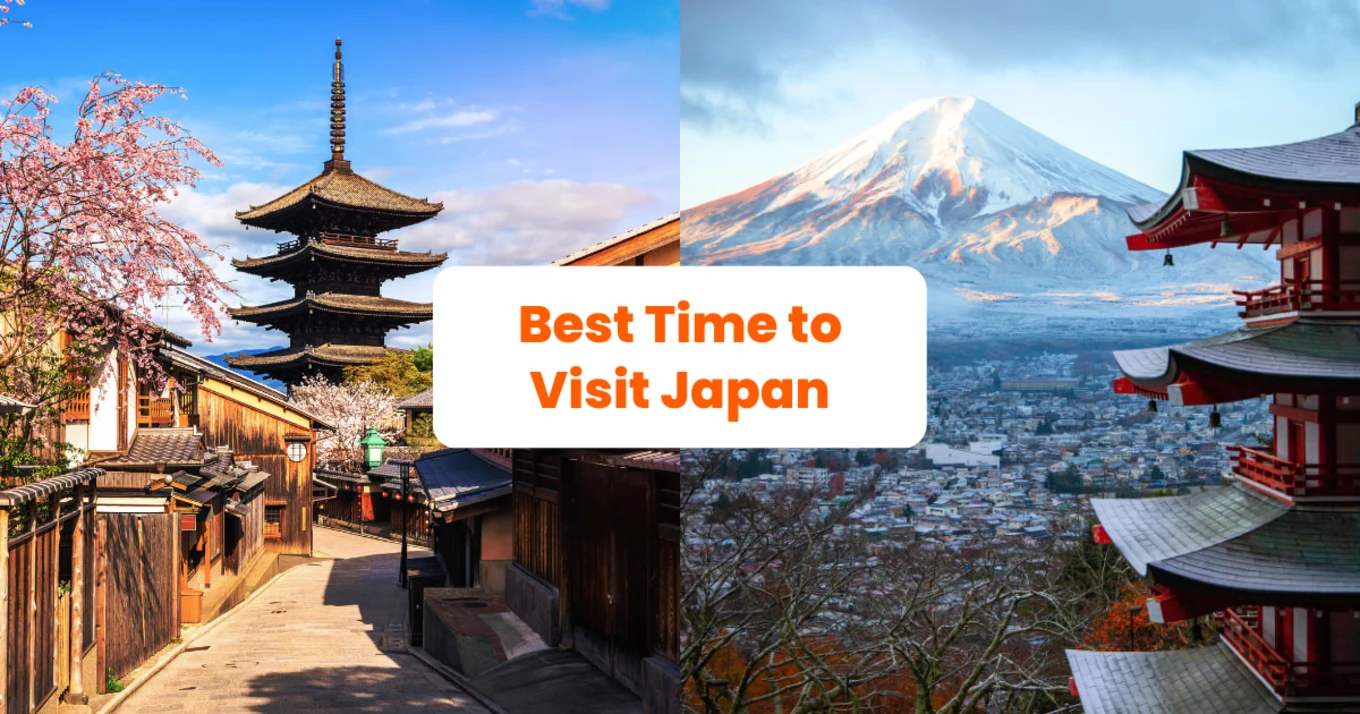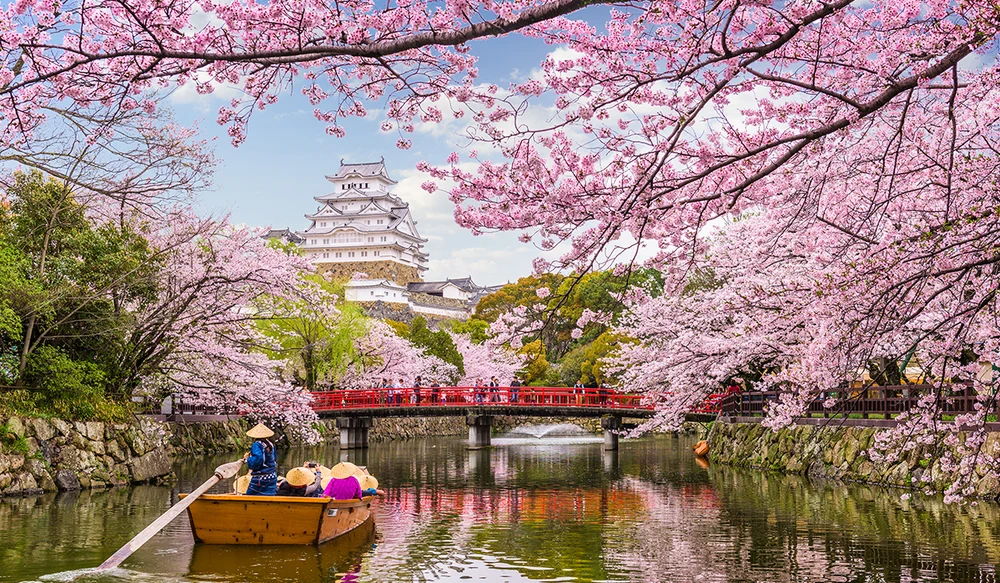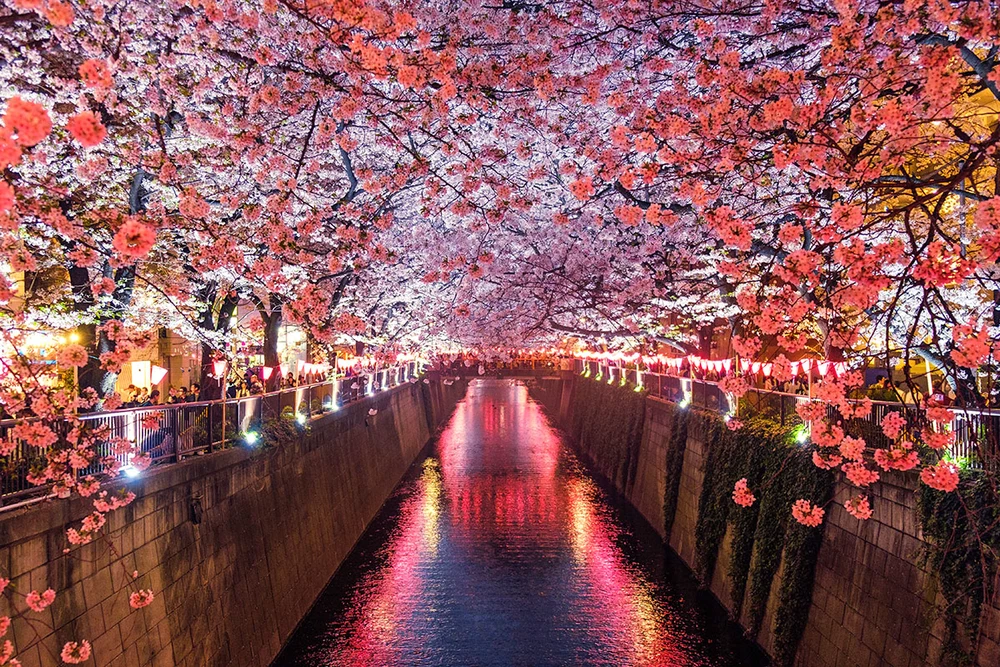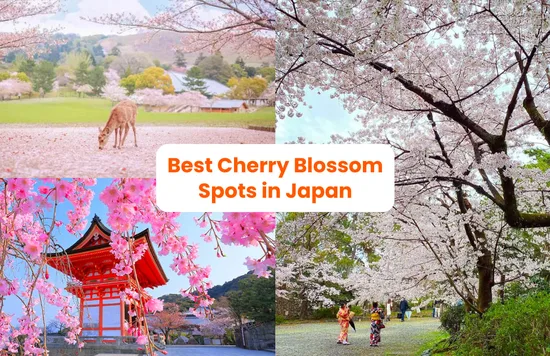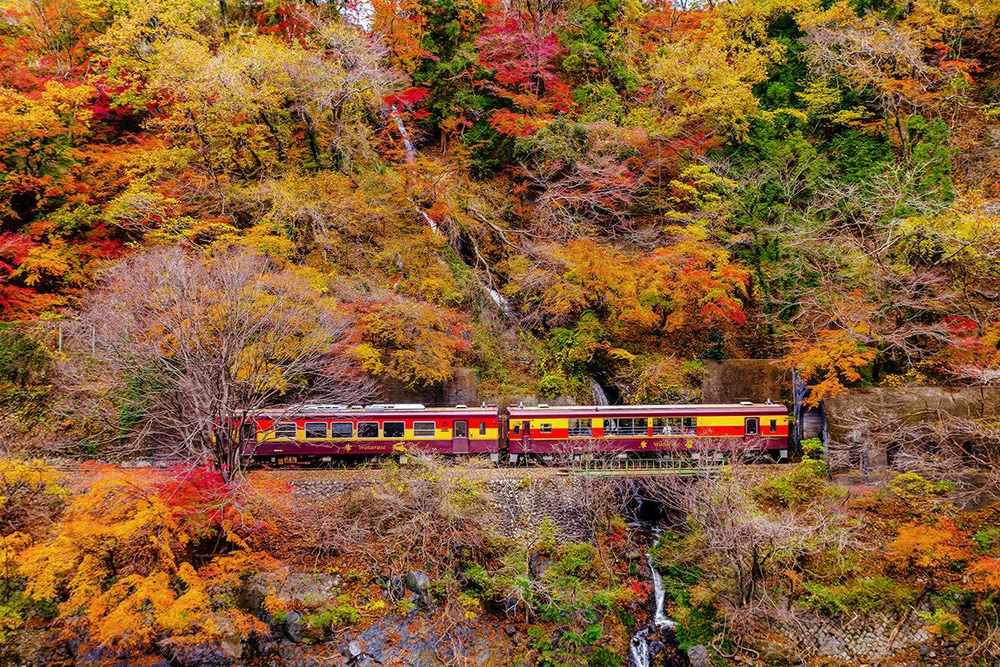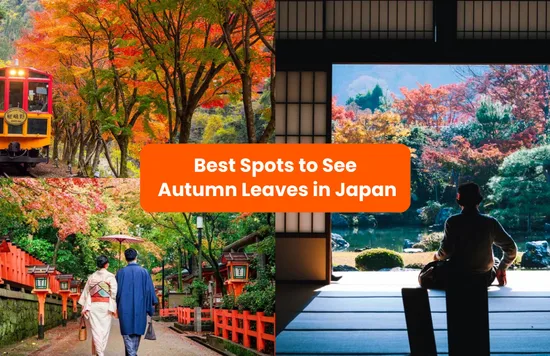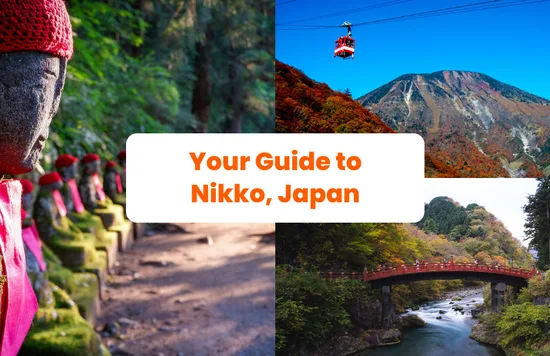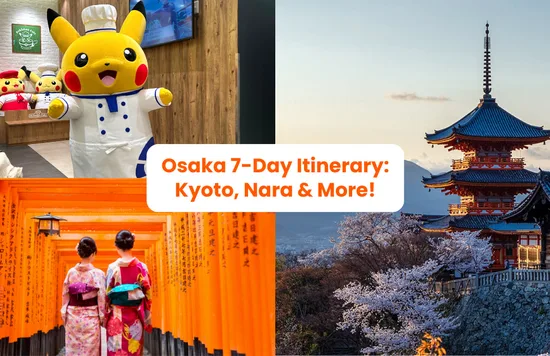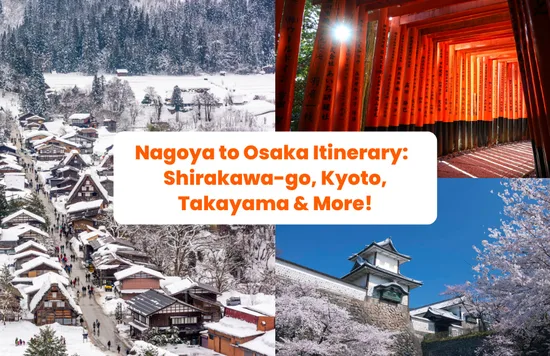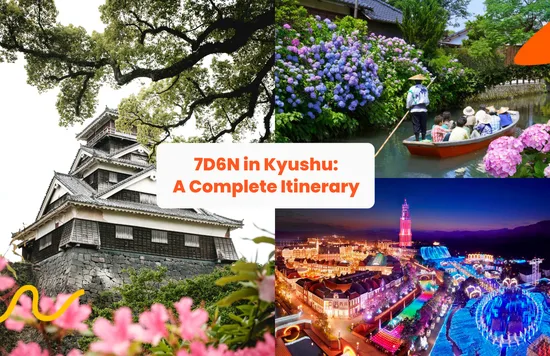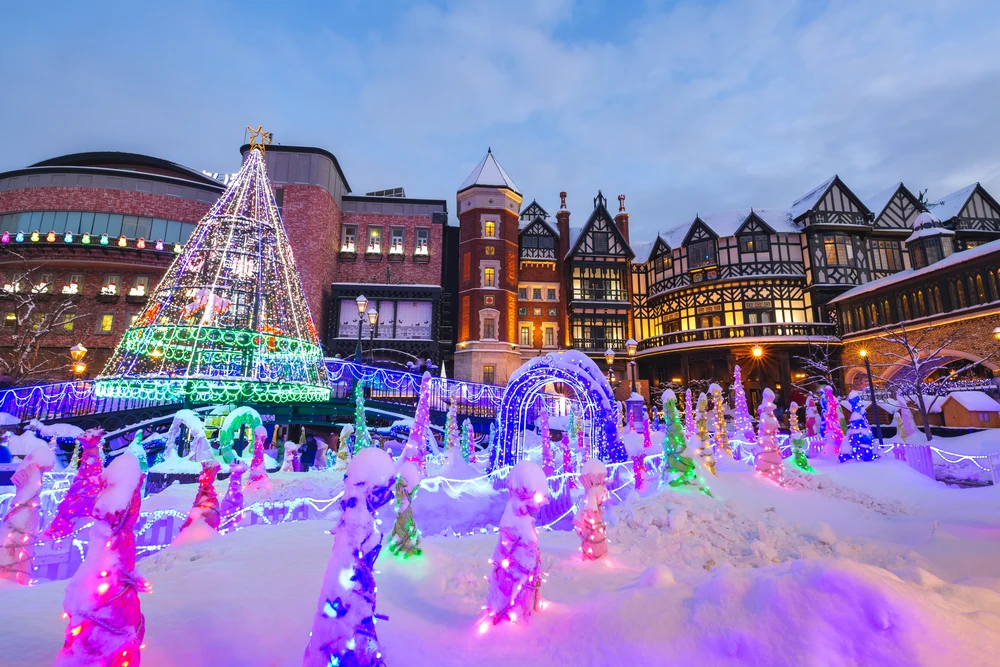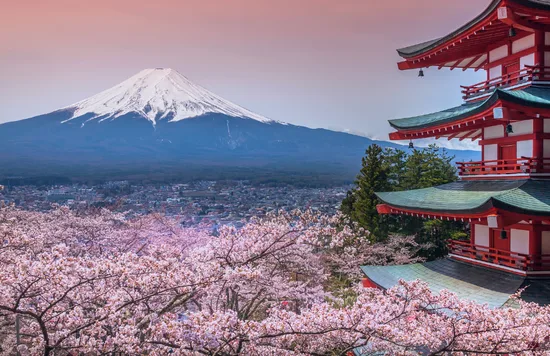Find out when's the best time to visit Japan and when to avoid the crowds
It is no wonder Japan is one of the top travel destinations. After all, it offers an array of experiences that cater to all travellers - whether you're a history enthusiast, a nature lover, a foodie, or an adventure seeker, Japan is sure to captivate your heart and ignite your curiosity.
But often, the question remains... When's the best time to visit Japan?
Are you looking to enjoy the delicate beauty of cherry blossoms in spring, bask in the sun on pristine beaches in summer, marvel at the vibrant autumn foliage, or embrace the magic of a snowy winter landscape? There are so many experiences awaiting you in Japan, a land of four distinct seasons, each offering unique charms and unforgettable memories.
Let's journey through the seasons and discover the best (and worst) time to visit Japan!
✨ Get ready to discover The Best You ✨
🗺 Are you a Polaroid Soul, Main Character, or full-on Chaos CEO? Whatever your vibe, there’s an adventure with your name on it.
🤗 Send this to your travel crew and see who’s your ultimate match!
➡️ Take the quiz now: ExperienceTheBestYou.com
PS: Looking for more sweet deals and promos? Check out allll the Klook promo codes available here - with more promos updated every month!
Best Months to Visit Japan
Timing is everything when planning a trip to Japan. You might want to catch the breathtaking cherry blossoms in April and May or embrace the mesmerizing autumn colours in November. Perhaps you dream of a winter wonderland, so January and February are ideal for you. Knowing the best time to visit Japan is crucial for a memorable experience.
Japan’s allure isn’t season-dependent, as it continually captivates visitors with its year-round beauty.
April and May: Spring Sakura Blooms
Early April and May are truly magical months in Japan, as the country erupts in a spectacular display of cherry blossoms. Known as sakura, these delicate pink and white flowers symbolize the transient beauty of life and are celebrated with hanami parties, where friends and family gather under the blossoming trees for picnics and festivities.
The mild weather, typically around 14°C (58°F), provides the perfect backdrop for exploring the vibrant landscapes.
Spring in Japan is not only about the cherry blossoms. It is also a time when a variety of other flowers bloom, adding to the vibrancy of the season. These include azaleas, wisteria, tulips, daffodils, and lilacs, each contributing their unique hues and fragrances to the springtime landscape.
These flowers create a visual feast for the senses and add to the beauty of the season. And to make spring even more memorable, there are also a host of spring festivals to enjoy.
November: Autumn Colors
If you’re seeking a serene, picturesque escape, look no further than November in Japan. With the arrival of autumn, the country is painted in vibrant shades of red, orange, and yellow, as the leaves on trees like maple and ginkgo transform into blazing hues. The cooler temperatures and fewer crowds compared to May make it an ideal time to explore both cityscapes and the countryside.
Don’t miss out on Japan’s famous autumn foliage spots, such as Nikko, Naruko Gorge, and Chichibu, where nature’s artistry can be admired in all its glory.
January and February: Winter Wonderland
Winter in Japan is a season of wonder and enchantment, as the landscape transforms into a snowy paradise. The crisp, cold air is invigorating, and the sun often shines brightly on the glistening snow. With fewer tourists around, you can fully immerse yourself in the beauty of Japan’s winter wonderland.
Skiing and snowboarding enthusiasts will find plenty of opportunities to hit the slopes, while those seeking relaxation can indulge in a steaming hot spring bath amidst snowy surroundings. And let’s not forget the Sapporo Snow Festival, one of the world’s most famous winter celebrations, showcasing incredible ice sculptures and illuminations that will leave you in awe.
Weather in Japan by Regions
Japan’s climate varies significantly depending on the region, with each area offering its own unique weather patterns, making Japan weather quite diverse. The northern regions, like Hokkaido and Tohoku, experience colder weather with heavy snowfall, while the central regions of Kansai and Nagano enjoy more moderate weather.
In the southern regions of Kyushu and Okinawa, you’ll find warmer temperatures and a subtropical climate, perfect for beach lovers. A grasp of Japan’s varied climate is key to optimizing your travel plan and fully experiencing this intriguing nation.
Northern Regions: Hokkaido and Tohoku
For those who delight in winter wonderlands, the northern regions of Hokkaido and Tohoku are your dream destination. Colder temperatures and heavy snowfall provide the perfect setting for skiing, snowboarding, and other winter activities.
With an average of three to six meters (10 to 20 feet) of snow during the cold weather, these regions offer breathtaking scenery and unforgettable experiences, from snow-covered landscapes to relaxing hot spring baths.
Hokkaido and Tohoku are also great places to visit during the summer. As the rest of Japan can get quite hot and humid, these northern regions remain relatively cool around 20℃, providing a refreshing escape from the summer heat. Whether you're exploring beautiful lavender fields in Furano or enjoying the mild weather in Tohoku's picturesque landscapes, a summer visit to these regions is sure to provide a unique and enjoyable experience.
Central Regions: Kansai and Nagano
The central regions of Kansai and Nagano offer a delightful mix of urban and rural landscapes, with moderate temperatures and a variety of seasonal attractions. These areas have a comfortable climate that is ideal for exploring Japan’s rich history and culture. In the summer months, the weather can get quite warm, with temperatures often reaching a high of 30°C. Despite the heat, summer is a great time to visit as the region comes alive with vibrant festivals and outdoor activities. Be sure to stay hydrated and protect yourself from the sun!
Whether you’re visiting the iconic cities of Kyoto and Osaka, or venturing off the beaten path to discover hidden gems, Kansai and Nagano promise a memorable journey through the heart of Japan.
From the ancient temples that are a testament to Japan's historical past to the bustling cities that showcase its modernity, every corner of these regions has something unique to offer. The serene countryside offers a peaceful retreat from the urban hustle, and the picturesque mountains provide breathtaking views that will leave you in awe.
Southern Regions: Kyushu and Okinawa
For sun-seekers and beach lovers, the southern regions of Kyushu and Okinawa are an absolute paradise. Boasting warmer temperatures and a subtropical climate, these areas are home to stunning beaches, crystal-clear waters, and lush greenery.
Dive into the vibrant underwater world of Okinawa, relax on the pristine sands of Kyushu or embark on an island-hopping adventure among the countless idyllic isles that dot the azure sea.
For those who are looking to dive into the captivating underwater world, the best time to visit is during the summer months, specifically from May to October. During this period, the waters around Okinawa and Kyushu are at their warmest and clearest, providing excellent visibility for divers. The marine life is also more active, allowing you to encounter a variety of vibrant coral reefs, tropical fish, and even sea turtles. So, if you're an underwater enthusiast, plan your trip during this time to enjoy the best diving experience in Japan.
Japanese Festivals and Events by Seasons
Throughout the year, Japan hosts a diverse mix of fascinating festivals and events, reflecting the country’s rich cultural heritage. From lively summer matsuri to serene cherry blossom viewings and enchanting winter illuminations, each season brings special celebrations that allow you to immerse yourself in the vibrant traditions and customs of Japan.
Here are some of the most celebrated festivals and events occurring annually that you shouldn't miss!
Spring Festivals
Spring in Japan is a time of renewal and celebration, marked by the much-anticipated cherry blossom festivals during the sakura season. During this period, locals and tourists alike flock to parks and gardens to admire the delicate pink and white blossoms, participating in hanami parties and other festivities.
Summer Festivals
Summer in Japan is a lively and energetic season, filled with traditional matsuri (festivals) that showcase the country’s vibrant culture. Some of the most famous summer festivals in Japan are Kyoto’s Gion Matsuri, Osaka’s Tenjin Matsuri, Aomori Nebuta Matsuri, and Awa Odori in Tokushima.
You can also look forward to hundreds of hanabi, fireworks, festivals all around Japan during this season. These festivals provide a unique glimpse into the heart and soul of Japan, offering an experience filled with lively music, colorful costumes, and jaw-dropping performances that are a feast for the senses.
Autumn Festivals
As the leaves begin to change colour and the air turns crisp, Japan embraces the beauty of autumn with a series of festivals and events that celebrate the season. Fall foliage events, such as the Fuji Kawaguchiko Autumn Leaves Festival and the Meiji Jingu Ginkgo Festival, draw crowds eager to witness the stunning transformation of nature.
Meanwhile, harvest festivals like Otsukimi and Takayama Autumn Festival pay homage to the bounty of the land and the changing of the seasons.
Winter Festivals
Winter in Japan offers a magical atmosphere, as snow and ice transform the landscape into a wonderland. Winter festivals, such as the Sapporo Snow Festival and Lake Shikotsu Ice Festival, feature awe-inspiring ice sculptures and illuminations that light up the night sky.
New Year’s celebrations, marked by visits to temples and shrines, provide a glimpse into Japan’s spiritual traditions, while other events like the Saidaiji Eyo and Somin-sai showcase the country’s unique customs and rituals.
When to Avoid Visiting Japan (a.k.a. Worst Times to Visit Japan)
Although Japan offers year-round attractions, some periods are better avoided due to inflated prices, overwhelming crowds, and adverse weather conditions. Peak travel seasons, such as Golden Week and Japan’s school holidays, can lead to congested tourist attractions and increased costs for accommodations and transportation.
You will also have to pay more to enter theme parks like Tokyo Disneyland and Universal Studios Japan as they practice peak pricing tiers.
Scheduling your visit outside these peak periods allows for a less crowded, more authentic Japanese experience. Not to mention, cheaper too!
Golden Week
Golden Week, which takes place from late April to early May, is a series of national holidays that result in high prices and crowded tourist attractions. While the weather is typically pleasant during this time, the influx of domestic travellers makes it difficult to secure accommodations and enjoy popular sites without the hassle of large crowds.
In 2024, Japan's Golden Week will take place from 29 April to 5 May 2024.
#KlookTip: Always book your activities, hotels, and even train tickets way ahead of time if you're planning to visit during Golden Week. Do also expect higher than usual prices for major attractions and hotels.
Silver Week
Silver Week, which occurs in mid-September, is another busy travel period in Japan. Similar to Golden Week, the combination of national holidays leads to increased prices and congested tourist attractions.
While the weather is still warm and inviting, it’s best to plan your visit during the best time to visit Japan, which is outside of Silver Week to avoid the crowds and make the most of your time in the country.
In 2024, Japan's Silver Week will take place from 16 to 23 September 2024.
Japan School Holidays
The busiest time for domestic travel in Japan is during the school holidays, which typically take place from mid-July to mid-August. However, mid-June can also see an increase in tourist activity. During these times, popular tourist attractions and accommodations can become crowded and expensive.
By planning your trip outside of these peak periods, you can enjoy a more relaxing and authentic experience of Japan’s unique culture and natural beauty.
Travel Tips for Visiting Japan by Seasons
When planning your trip to Japan, consider the distinct weather conditions and necessary attire for each season. Dressing appropriately and being prepared for seasonal events and activities will ensure you have the best possible experience during your visit. Here are some tips for what to pack and expect during each season in Japan.
Spring Travel Tips
For your spring journey to Japan, it's important to pack with the season's weather in mind. This includes clothing that can be layered, as the temperatures can shift from day to day. Rain protection is another must-have, as spring showers are a common occurrence. Lastly, don't forget to bring comfortable walking shoes, as Japan's numerous parks and gardens are waiting to be explored.
Most importantly, don’t forget your camera to capture the beauty of Japan’s cherry blossoms and other spring blooms!
Summer Travel Tips
In preparation for a summer trip to Japan, be sure to pack lightweight clothing to help you stay cool in the hot and humid climate. It's also important to bring sunscreen to protect your skin from the sun, and a water bottle to ensure you stay hydrated throughout your adventures.
The weather can be unpredictable, with occasional rain showers, especially during the rainy season in June and the typhoon season in August and September. So, it's always a good idea to have an umbrella or raincoat handy.
Autumn Travel Tips
When planning your autumn trip to Japan, it's important to consider a few things. Firstly, temperatures drop during this season, so it's essential to pack warm clothing such as long-sleeved shirts, sweaters, and jackets. A light coat can also be handy for chillier days and evenings.
As you'll likely be spending a lot of time outdoors admiring Japan’s stunning fall foliage or participating in activities like hiking and cycling, comfortable and breathable footwear is a must. Lastly, remember that typhoon season can bring sudden rain, so it's always a good idea to have rain gear with you.
Winter Travel Tips
For a winter trip to Japan, pack warm clothing, including insulated jackets, scarves, gloves, and waterproof shoes. With snowfall common in many regions, it’s essential to stay warm and dry during your adventures. Also, keep in mind that daylight hours are shorter in winter, so plan your activities accordingly to make the most of your time in Japan.
Frequently Asked Questions
What is the best month to go to Japan?
The best time to visit Japan is during spring (March to May) or autumn (September to November), when the scenery comes alive with cherry blossoms and red leaves. However, it can get quite crowded at this time too!
When is the cheapest time to go to Japan?
The cheapest time to go to Japan is during the winter months of December to mid-March, after the holidays pass. Mid-January to mid-March are also the least crowded times, so you can expect great deals on airfare and hotel rooms.
What is the lowest tourist season in Japan?
Winter is the lowest tourist season in Japan due to the cold temperatures and fewer crowds after the holidays pass. Prices are also lower during this time of year, making it a great choice for frugal travellers.
What month does Japan have the most tourists?
Japan's peak tourist season is from March to May, and again from September to November. These months provide visitors with pleasant temperatures and plenty of sightseeing opportunities.
What are the best months to see cherry blossoms in Japan?
The peak of the spring season is the best time to view cherry blossoms in Japan, typically falling in April and May.
Explore more of Japan with us!
Japan Travel Essentials 🇯🇵
Planning a Japan holiday? Here's our checklist of travel essentials for a smooth and hassle-free trip!
🚅 For starters, the Whole Japan JR Pass is a must for your adventures. It will come in useful when you are exploring various cities! However, if you are only spending time in one particular city or region, then a Regional JR Pass might be a better choice.
🏮 Tokyo Essentials: Transportation Passes & Top Must-Dos
➡️ Want to save more on Tokyo transportation passes and attraction tickets? Hit all your favourites and save up to 48% with the Klook Pass Tokyo!
🏮 Osaka Essentials: Transportation Passes & Top Must-Dos
➡️ Want to save more on Osaka transportation passes and attraction tickets? Hit all your favourites and save up to 43% with the Klook Pass Osaka!
✨ Others
➡️ Exhilarating adventures lined up on your next trip itinerary?
Protect yourself and your loved ones while you experience the world with Klook’s travel insurance! Learn more about why you should book travel insurance and how to level up your travels today.
🤩 Book Your Hotel with Klook Stay+
Heard of Klook Stay+? Here's how you can bundle your hotel booking with the best activities your destination has to offer, so you can explore more, spend less and easily plan your trip!
What Can I Enjoy with Klook Stay+?
- Up to 50% Off - Book a bundle and get up to half price off your hotel or activity
- Lots of Options - Choose from attractions, transport, WiFi/SIM and more to bundle with
- Essentials Included - Book your ideal room and trip essentials all in one place
👉🏼 Check out all Stay+ bundles here: https://www.klook.com/en-SG/hotels/stayplus/
🏨 Check out ALL our Hotel Promotions
- Save up to $90 on your hotel stay when you book on Klook!
👉🏼 Check out all hotel deals here: https://www.klook.com/en-SG/tetris/promo/sghotels

